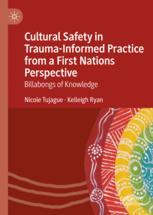Who This Book Is for This book was written for you, the Indigenous professional working at the grassroots, the student who is preparing to work in this space and for our non-Indigenous allies who work and study alongside us. You may have picked up this book because you, like us, care about the wellbeing of First Nations Peoples and communities and your work is far more than just a job. If you are a student, thank you for having the courage to learn about cultural safety in trauma-informed practice before you enter our communities. We have written this book with care, respect and down to earth practical knowledge about trauma-informed practice. What you will read about is critical to understand because of Australia’s stories of colonisation, genocide and displacement of people from Country. The devastating impacts of early colonisation in Australia are just as potent today. These impacts have forged a gap in social and health outcomes between the expectations of the general Australian population and the N. Tujague and K. Ryan 3 experience of Australia’s First Nations Peoples. We know you will find some useful information that supports your work. We trust it will enhance your understanding of the clinical and cultural implications of the impacts of colonisation on First Nations Peoples across the world. The book is designed to be an addition to your toolkit. Take care of yourself as you work through these pages and keep your mind and heart open as you learn through the lens of First Nations Peoples. Nicole and Kellei
چکیده فارسی
این کتاب برای چه کسی است این کتاب برای شما، متخصص بومی که در پایه کار می کنید، دانش آموزی که برای کار در این فضا آماده می شود و برای متحدان غیر بومی ما که در کنار ما کار و مطالعه می کنند، نوشته شده است. ممکن است این کتاب را انتخاب کرده باشید زیرا شما نیز مانند ما به رفاه مردم و جوامع اولین ملل اهمیت می دهید و کار شما بسیار فراتر از یک شغل است. اگر دانش آموز هستید، از شما به خاطر شجاعت این که قبل از ورود به جوامع ما در مورد ایمنی فرهنگی در تمرینات آگاه از تروما بیاموزید، سپاسگزاریم. ما این کتاب را با دقت، احترام و دانش عملی در مورد تمرین آگاهانه از تروما نوشته ایم. آنچه در مورد آن خواهید خواند به دلیل داستان های استرالیا در مورد استعمار، نسل کشی و جابجایی مردم از کشور برای درک بسیار مهم است. تأثیرات ویرانگر استعمار اولیه در استرالیا امروز به همان اندازه قوی است. این تأثیرات شکافی را در پیامدهای اجتماعی و بهداشتی بین انتظارات جمعیت عمومی استرالیا و تجربه N. Tujague و K. Ryan 3 از اولین ملل استرالیا ایجاد کرده است. ما می دانیم که اطلاعات مفیدی پیدا خواهید کرد که از کار شما پشتیبانی می کند. ما اطمینان داریم که درک شما از پیامدهای بالینی و فرهنگی تأثیرات استعمار بر مردمان ملل اول در سراسر جهان را افزایش خواهد داد. این کتاب به گونه ای طراحی شده است که افزودنی به جعبه ابزار شما باشد. در حین کار کردن با این صفحات از خود مراقبت کنید و ذهن و قلب خود را باز نگه دارید، همانطور که از دریچه First Nations Peoples یاد می گیرید. نیکول و کلی
ادامه ...
بستن ...
Who Are We? A Personal Introduction to Us and Our Family You can read about our professional achievements in the front of this book, but here we share some of our personal story and family connec- tions. While the system of meritocracy wants to see evidence of our quali- fications and our achievements that gives us the right to talk in the non-Indigenous world, for Indigenous Peoples it is our cultural under- standings, lived experience and family connections that give us the right to speak in our world.
ادامه ...
بستن ...










